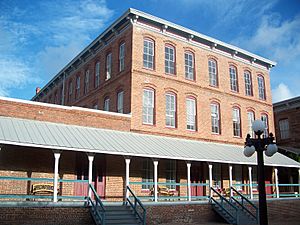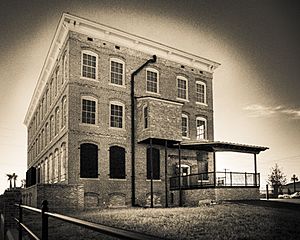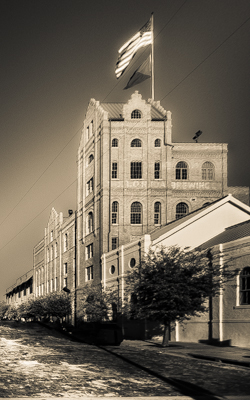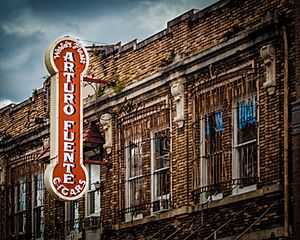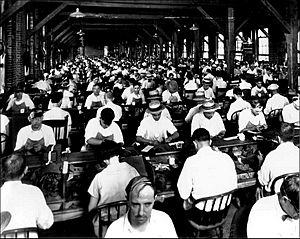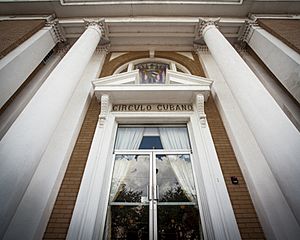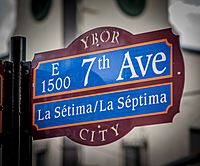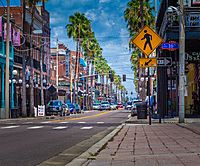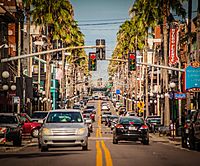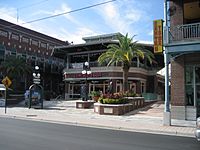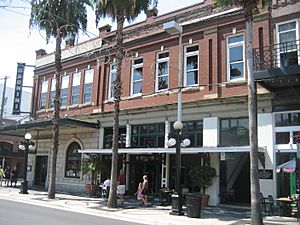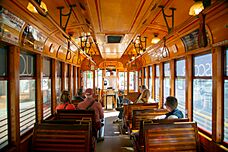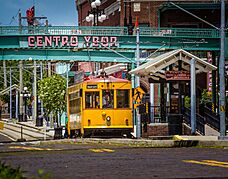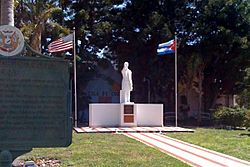Ybor City facts for kids
Quick facts for kids
Ybor City
|
||
|---|---|---|
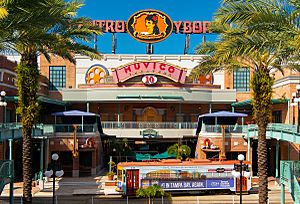
Centro Ybor complex with a TECO Line car passing in front
|
||
|
||
| Nickname(s):
Florida's Latin Quarter
|
||
| Country | United States | |
| State | Florida | |
| County | Hillsborough | |
| City | Tampa | |
| Founded | 1885 | |
| Incorporation into Tampa | 1887 | |
| Population | 4,341 (2020) | |
| Time zone | UTC-5 (EST) | |
| • Summer (DST) | UTC-4 (EDT) | |
| Website | https://www.yborcityonline.com/ | |
Ybor City (/ˈiːbɔːr/ EE-bor) is a special neighborhood in Tampa, Florida, United States. It's known for its rich history. The area was started in the 1880s by Vicente Martinez-Ybor and other people who made cigars. Thousands of immigrants, mostly from Cuba, Spain, and Italy, came to live and work here. For about 50 years, factories in Ybor City made hundreds of millions of cigars every year!
This neighborhood was unique for its time, especially in the southern United States. It had people from many different backgrounds and races. They also had many mutual aid societies, which were like community clubs. The cigar business created many good jobs. This helped Tampa grow from a small village to a busy city in just 20 years. Tampa even got the nickname "Cigar City."
Ybor City grew a lot from the 1890s until the Great Depression in the 1930s. During this time, people bought fewer fancy cigars. This meant fewer cigar factories and fewer jobs. After World War II, more people and businesses left. By the late 1970s, many parts of the neighborhood were empty. But in the 1980s, artists started moving in. This began a slow process of making the area popular again. In the 1990s and early 2000s, the area around 7th Avenue became a fun place with nightclubs and entertainment. Many old buildings were fixed up for new uses. Now, Ybor City has more offices and homes, and its population is growing again.
Ybor City is recognized as a National Historic Landmark District. This means it's a very important historical place. Many buildings here are also listed on the National Register of Historic Places. In 2008, 7th Avenue, the main street in Ybor City, was called one of the "10 Great Streets in America." Also, in 2010, the Columbia Restaurant, which is Florida's oldest restaurant, was named a "Top 50 All-American icon."
Contents
History of Ybor City
How Ybor City Started
In the early 1880s, Tampa was a small, quiet village with less than 1,000 people. Its economy was not doing well. But Tampa had a good port and a new railroad line built by Henry Plant. It also had a humid climate, which was perfect for making cigars. These things caught the eye of Vicente Martinez Ybor, a famous Spanish cigar maker.
Ybor had moved his cigar business from Cuba to Key West, Florida in 1869. He did this because of political problems in Cuba, which was a Spanish colony at the time. But in Key West, there were worker strikes and not enough space to grow his business. So, he started looking for a new place, hoping to build his own company town.
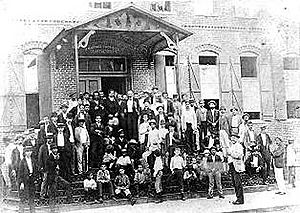
Ybor looked at several places in the southern United States. He decided that a sandy area northeast of Tampa would be the best spot. In 1885, the Tampa Board of Trade helped him buy about 40 acres of land. Ybor quickly bought even more land.
Making cigars was a special skill. Tampa did not have enough workers who knew how to do it. To get employees, Ybor built hundreds of small houses. These were for the many Cuban and Spanish cigar workers who would come. Many workers followed him from Key West and Cuba. Other cigar makers also moved to Ybor City because Ybor offered them help. This quickly made Tampa a major center for making cigars.
Italians were also among the first people to settle in Ybor City. Most of them came from a few villages in southwestern Sicily. These villages included Santo Stefano Quisquina and Alessandria della Rocca. Many Italians came with their whole families, which was different from other immigrants. The number of Italians born outside the U.S. in Tampa grew a lot between 1890 and 1940. When they arrived, Italians mostly settled in the eastern and southern parts of Ybor City. This area was sometimes called "Little Italy."
At first, many Italians did not have cigar-making skills. They often started with jobs that did not involve handling tobacco. They worked as sweepers, haulers, and doorkeepers. Over time, many Italians, including women, became skilled cigar makers. Other Italian immigrants started small businesses. These included cafés, food stores, restaurants, and boardinghouses. These businesses supported the cigar industry.
Other groups also came to Ybor City, like Germans, Romanian Jews, and Chinese people. Chinese and Jewish immigrants mainly worked in service jobs and stores. Germans arrived after the 1890s. Most of them were business owners. In the cigar factories, Germans often worked as managers or supervisors. German-owned factories also made cigar boxes. The Germans even had their own club, the Deutsch Amerikanischer Verein. This club building is still standing today.
In 1887, Tampa officially added Ybor City to its area. By 1900, the rough settlement of wooden buildings had changed a lot. It became a busy town with brick buildings, paved streets, and a streetcar line. There were also many social and cultural activities. Because Ybor City grew so much, Tampa's population jumped to almost 16,000 people.
The Golden Age of Ybor City
Ybor City grew and did very well during the early 1900s. Thousands of people built a community that mixed Cuban, Spanish, Italian, and Jewish cultures. One visitor described Ybor City as "Tampa’s Spanish India." They said it was a "colorful, screaming, shrill, and turbulent world."
A very important part of life in Ybor City were the mutual aid societies. These clubs were built and supported by regular citizens. The first one, the Centro Español, started in 1891. Members paid dues, usually 5% of their salary. In return, members and their families received many benefits. These included free libraries, educational programs, sports teams, and restaurants. They also had social events like dances and picnics, and free medical care. These clubs were like extended families and gathering places for many generations of Ybor City residents.
There were different clubs for each ethnic group. For example, there was the Deutscher-Americaner Club for Germans. L’Unione Italiana was for Italians. El Circulo Cubano was for light-skinned Cubans. La Union Marti-Maceo was for darker-skinned Cubans. El Centro Español was for Spaniards. The largest club was El Centro Asturiano, which welcomed members from any background.
Even though there was little racism within Ybor City itself, Tampa's Jim Crow laws at the time kept Afro-Cubans from joining the same social clubs as their lighter-skinned countrymen. Sometimes, even within the same family, differences in skin color meant people couldn't join the same Cuban club. Generally, the clubs had friendly rivalries. Families would sometimes switch clubs to find the best services or events.
Cigar production was at its highest in 1929. That year, 500,000,000 cigars were made in Ybor City factories. This was also the year the Great Depression began.
Decline and Recovery
The Great Depression hit cigar makers very hard. People around the world bought fewer cigars. They wanted to save money by buying cheaper cigarettes instead. Factories responded by letting workers go or closing down. This continued through the 1930s. The remaining cigar factories started using machines instead of hand-rolling cigars. This made cigars cheaper to produce but meant even fewer jobs and lower pay for workers.
After World War II, many soldiers came home. They chose to leave Ybor City because there weren't many good jobs. Also, a government program for home loans only applied to new homes. There were very few new homes in Ybor City. The existing homes were also getting old and needed repairs.
Through the 1950s and 1960s, the historic neighborhood continued to empty out. The federal Urban Renewal program tried to fix the area. It aimed to tear down old buildings and build new homes and businesses. Many old buildings were torn down, but new ones were not built due to a lack of money. This left many empty lots for decades. Also, the building of Interstate 4 through the middle of the neighborhood destroyed many buildings. It also cut off most of the north-south roads.
By the early 1970s, very few businesses and residents were left. Only a few places, like the Columbia Restaurant, remained on 7th Avenue.
Ybor City's Recovery
In the early 1980s, artists started moving into Ybor City. They were looking for interesting and affordable places to work. This began a slow recovery for the area. By the early 1990s, many old, empty brick buildings on 7th Avenue were changed into bars, restaurants, and nightclubs. So many people visited that the city built parking garages. They even closed 7th Avenue to car traffic to make it easier for visitors.
Since about 2000, the city of Tampa and the Ybor City Chamber of Commerce have worked to bring more types of businesses to the area. With help from the city, Centro Ybor opened. It's a shopping complex and movie theater for families. It's located in the old Centro Español social club building. New apartments, condos, and a hotel have been built on empty lots. Old buildings have also been fixed up and turned into homes and hotels. New residents are moving into Ybor City for the first time in many years. The areas around 7th Avenue are also busy with restaurants, nightlife, and shops.
Ybor City's Boundaries
Historically, the larger area of "Greater Ybor City" was very big. It stretched from Tampa Bay in the south to Dr. Martin Luther King Jr. Blvd. in the north. It went from Nebraska Avenue in the west to 40th Street in the east. This included several neighborhoods we know today. The Ybor City Historic District is the central part of this area. It is split by Interstate 4, which was built in the 1960s.
The official boundaries of the Historic Ybor neighborhood are I-4 to the north, 22nd Street to the east, Adamo Drive to the south, and Nebraska Avenue to the west. This area is about 1 square mile. Modern Ybor City also includes some nearby areas. However, its exact size is not always clearly defined.
Population Growth
When Ybor City was a busy immigrant community, tens of thousands of people lived there. At its lowest point in the late 1970s, only about 1,000 residents called the neighborhood home.
In recent years, the number of people living in Ybor City has started to grow again. Between 2000 and 2003, Ybor City's population grew by about 42.5%. This was mainly because new condos and apartments were built. As of 2003, about 2,900 people lived in the area.
Economy and Land Use
Ybor City is one of the oldest parts of Tampa. It is mostly an urban area with many different types of buildings. Commercial properties, like stores and offices, make up almost 50% of the land. Buildings for public use, like the Sheriff's Operations Center and a college campus, use 16% of the land. Homes use about 23%, and industrial areas use about 7%.
A survey from 2003 showed the top five types of businesses in the area. These were professional services (like lawyers), retail stores, manufacturing (making things), wholesale/distribution (selling things in bulk), and restaurants & bars.
Transportation in Ybor City
Ybor City still uses the grid system of streets. This plan was first laid out in 1885. Many roads are now paved with modern materials. However, a few streets still have their original brick paving.
For many years, 21st and 22nd Streets were the main routes for large trucks. These trucks traveled between Interstate 4 and the Port of Tampa Bay. This caused a lot of truck traffic in the historic district. It damaged the narrow city roads and was dangerous for people walking. Sometimes, trucks even hit historic buildings. In 2014, a new elevated road, the I-4/Selmon Expressway Connector, was built. This helped move heavy truck traffic away from the historic district.
The TECO Line Streetcar started running in October 2002. It connects Ybor City, the Channelside District, and Downtown Tampa. The Hillsborough Area Regional Transit Authority (HARTline) operates the streetcars and the bus system. Small companies have also started using electric vehicles to take passengers between Tampa's main neighborhoods, including Ybor City.
Museums to Visit
- Cigar Museum And Visitor Center, Ybor City
- Ybor City Museum State Park
- TECO Line Streetcar Museum
- Tampa Baseball Museum
Annual Events and Festivals
- Sant'Yago Knight Parade (also called Gasparilla Night Parade) - This parade usually happens two weeks after the Gasparilla Pirate Festival in mid to late February.
- Guavaween - This event has daytime activities and a parade at night in October. It's named after Tampa's nickname, "The Big Guava."
- Historic Ybor City's Annual Tree Lighting Ceremony - This event started in 2010 and is held every year in November.
Famous People from Ybor City
- Braulio Alonso, the first Hispanic president of the National Education Association.
- Dick Greco, who served many terms as mayor of Tampa.
- Al López, the first person from Tampa to play Major League Baseball. He also managed a major league team and is in the Baseball Hall of Fame.
- Baldomero Lopez, who received the Medal of Honor during the Korean War.
- Nick Nuccio, the first Italian mayor of Tampa.
- Ferdie Pacheco, a well-known boxing personality, artist, and writer.
- Jose Yglesias, an author.
- Cesar Gonzmart, a concert violinist and entertainer, who was also the energetic chairman of the Columbia Restaurant Group.
See also
 In Spanish: Ybor City para niños
In Spanish: Ybor City para niños




